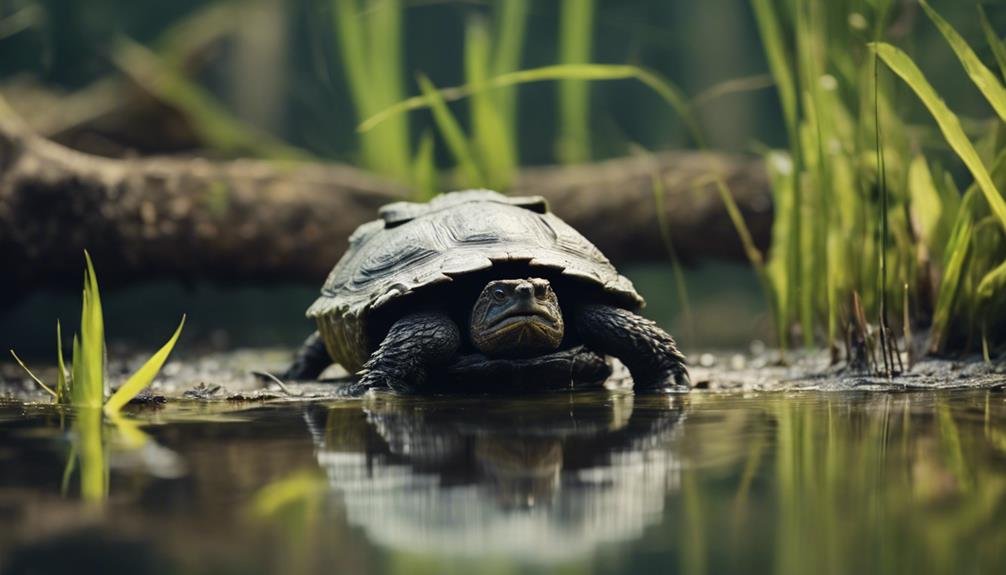Have you ever wondered what keeps snapping turtles thriving in their watery habitats? These intriguing creatures maintain a varied diet, primarily carnivorous, consuming anything from fish to frogs, and even occasionally birds. They’re not picky eaters; their ability to adapt their diet based on availability showcases their role as both predators and scavengers in aquatic ecosystems. This adaptability helps balance their ecosystems, but it leaves us questioning: how does this diverse diet affect their behavior and interaction with the environment? Understanding their eating habits not only enlightens us about their survival strategies but also about the broader ecological impacts they have.
Key Takeaways
- Snapping turtles are omnivorous, consuming 70% meat including insects, fish, birds, and small mammals.
- They also eat aquatic vegetation like algae, duckweed, and water lilies.
- Waterfowl, such as ducklings, are occasionally part of their diet.
- They employ a sit-and-wait hunting strategy, acting as ambush predators.
- Their diet includes both active hunting of live prey and scavenging dead animals.
Snapping Turtle Diet Overview
Snapping turtles, with their omnivorous appetite, consume about 70% meat including insects, fish, birds, and small mammals, along with aquatic vegetation and algae. As a common snapping turtle, you’d find your diet quite diverse, allowing you to guarantee to various environments and take advantage of multiple food sources.
You’d use your strong jaws and sharp, beak-like mouth to efficiently handle your prey. This includes crushing the shells of smaller animals or tearing through the tough exteriors of insects. Imagine patrolling your aquatic territory, your eyes peeled for movements that signal your next meal. Whether it’s a careless fish or an unsuspecting bird, you’re equipped to snatch it up.
Your role in the ecosystem is critical; you help maintain balance by controlling populations of smaller creatures. As snapping turtles eat, they make certain that no single species dominates, promoting biodiversity. This not only benefits you but the entire aquatic community.
Aquatic Vegetation and Plants
In addition to their carnivorous habits, you’ll find snapping turtles munching on aquatic vegetation such as algae, duckweed, and water lilies. These plants aren’t just a snack; they’re an essential part of their diet, offering important nutrients and fiber.
As you explore further, you’ll see that snapping turtles aren’t just eating for their own benefit. They play an essential role in controlling plant growth, helping to maintain a balanced aquatic ecosystem.
Feasting on these plants, snapping turtles contribute significantly to nutrient cycling in freshwater habitats. By breaking down the vegetation, they release nutrients back into the water, which supports other aquatic life forms.
This not only keeps the water bodies healthy but also ensures that plant populations don’t grow excessively, which could otherwise lead to overgrowth that stifles the ecosystem.
Common Animal Prey
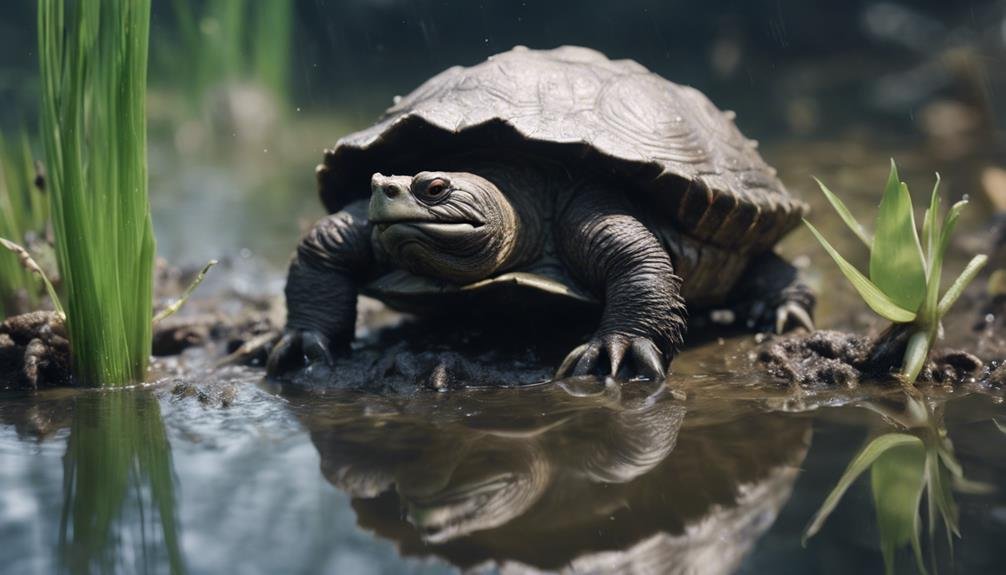

While primarily known for their carnivorous diet, snapping turtles consume a variety of animal prey, ranging from insects to geese. Due to their remarkable adaptability and powerful hunting skills, you’ll find these turtles feasting on whatever meat they can catch in their aquatic habitats.
Here’s a quick look at some common prey you might see a snapping turtle munch on:
- Insects: Small but plentiful, insects like beetles and crickets are easy targets for young or smaller snapping turtles.
- Fish: Fish form a significant part of their diet. Their stealth and speed allow them to capture fish with surprising ease.
- Amphibians: Frogs and tadpoles are common targets, especially in ponds and marshy areas where these turtles lurk.
These turtles are both scavengers and active hunters, often lying in wait under the water’s surface to ambush unsuspecting prey. Their diet reflects their environment, so it varies widely based on what’s available. However, what remains consistent is the snapping turtle’s role as a formidable predator in its ecosystem. They’re not just opportunistic feeders; they’re also equipped with long curved claws and a hard beak, making them well-adapted to a diet that’s heavy in animal prey.
Occasional Prey: Waterfowl
Beyond their regular diet, snapping turtles also occasionally target waterfowl, such as ducklings, when they become available in their environments. While you mightn’t think of these reptiles as typical predators of birds, their opportunistic nature drives them to take advantage of these feathered creatures whenever they can.
Waterfowl can be an important part of the varied diet that keeps snapping turtles thriving. As they patrol their aquatic territories, these turtles are always on the lookout for potential meals, and waterfowl often present a nutritious opportunity. The presence of ducks and other water birds in snapping turtle habitats increases during certain times of the year, especially during breeding seasons when ducklings are more vulnerable and abundant.
You’ll find that snapping turtles don’t discriminate much when it comes to food. Their omnivorous eating habits mean they’re as happy to snap up a careless duckling as they’re to munch on fish, frogs, or even occasionally vegetation. This flexibility in diet helps secure their survival in diverse environments where the availability of prey can be unpredictable. So, it’s no surprise that waterfowl are on the menu whenever they’re within reach of a hungry snapping turtle.
Hunting Techniques and Behavior
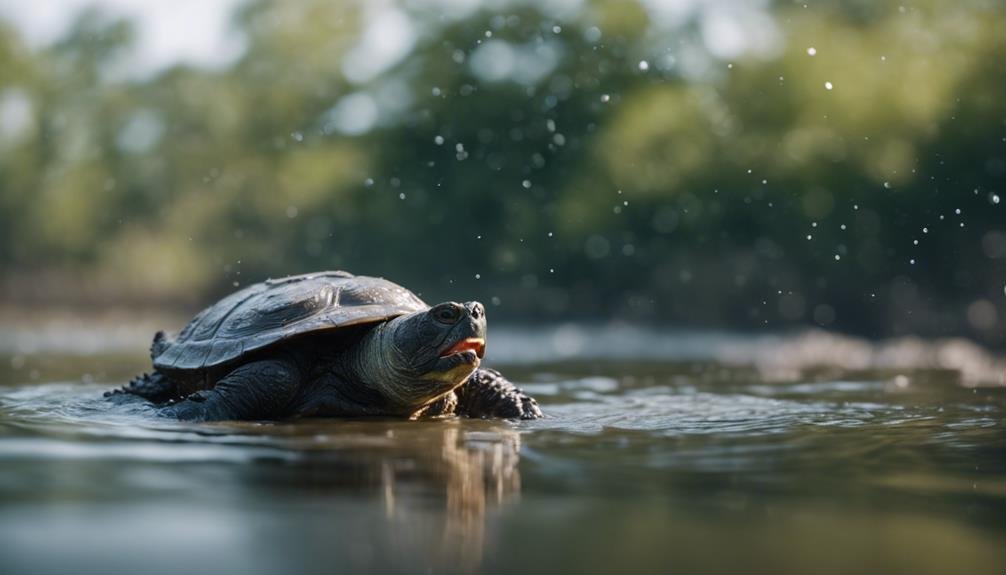

Snapping turtles employ a sit-and-wait strategy, often remaining motionless for hours until unsuspecting prey comes within striking distance. This hunting technique reflects their behavior as opportunistic feeders in their aquatic environments. You’ll find that their patience allows them to capitalize on a variety of prey, from fish that swim too close to waterfowl ducklings that venture near the water’s edge.
Their behavior in stalking prey is less about speed and more about stealth and timing. By blending into their surroundings, they can surprise prey with a swift attack. This method is especially useful given their not-so-fast mobility on land. Snapping turtles also make use of their powerful jaws, which can quickly snap and secure their food.
Here are some intriguing aspects of snapping turtle hunting techniques and behavior:
- Opportunistic Feeding: They don’t hesitate to eat dead animals, showcasing their less picky nature.
- Ambush Predators: Perfecting the art of the surprise attack from beneath the water’s surface.
- Diverse Diet: Their ability to eat both plant life and animals ensures they thrive in various environments.
This adaptability in diet and hunting tactics is crucial to their survival and success as predators in their habitats.
Impact on Ecosystems
Understanding the diverse diet and hunting behaviors of snapping turtles reveals their significant role in maintaining healthy ecosystems. As you explore their impact, you’ll find that these turtles aren’t just vital participants but active contributors to their environments. By preying on slower-moving fish, water snakes, and occasionally waterfowl ducklings, snapping turtles help regulate animal populations, preventing any single species from overwhelming the aquatic habitat.
Moreover, their taste for dead animals plays an important role in nutrient recycling. They consume carrion left in their habitats, which helps clean up the ecosystem. This scavenging behavior prevents the spread of disease and reduces the decay that can deplete oxygen levels in water bodies, essential for other aquatic life.
Snapping turtles also feed on a variety of invertebrates as well as amphibians and small mammals. This diet helps control the populations of these animals, maintaining a balance that supports diverse wildlife. Their interactions with both plants and animals ensure that they’re integral to the ecosystem’s health, aiding in the stability and sustainability of their habitats.
Feeding Pet Snapping Turtles
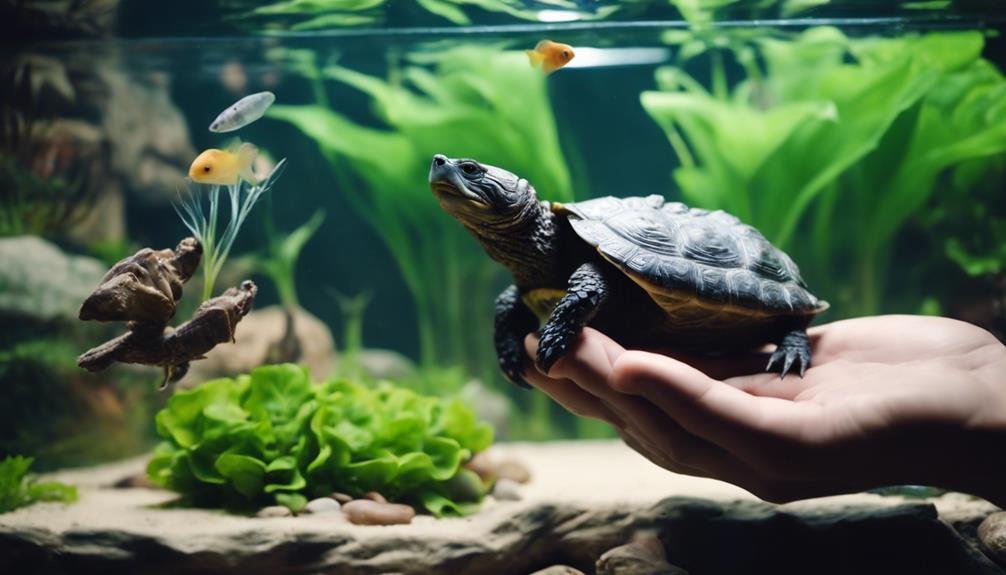

When feeding your pet snapping turtle, it’s crucial to provide a balanced diet that includes insects, fish, crustaceans, and aquatic plants. This variety not only guarantees that your turtle receives all the necessary nutrients but also keeps mealtime interesting for them. Turtles are natural hunters, and incorporating live fish can enhance their eating experience by stimulating their hunting instincts and providing mental enrichment.
Commercial turtle pellets are a great addition as they’re formulated to meet the dietary needs of turtles. However, you should complement these pellets with natural foods to mimic what turtles eat in the wild and prevent any nutritional deficiencies. Be cautious about the foods you choose; avoid anything toxic or unsuitable, such as raw meats or processed foods, which can harm your turtle.
Here are a few tips to keep in mind:
- Rotate the diet: Regularly change the types of insects, fish, and plants you feed your turtle to ensure a wide range of nutrients.
- Monitor food intake: Keep an eye on how much and how often your turtle eats to avoid overfeeding.
- Provide live feeding opportunities: Occasionally offer live prey to keep your turtle’s predatory skills sharp and ensure engagement.
Nutritional Needs and Preferences
Now let’s explore the specific nutritional needs and preferences that keep snapping turtles healthy and vigorous. As an omnivorous species, your turtle’s diet should mainly consist of meat, making up about 70% of its total food intake. This high protein diet supports their muscular health and overall vitality.
Variety is key in a snapping turtle’s diet. While they enjoy a range of animal-based foods—from insects to small mammals and even geese—they also need aquatic vegetation to balance their nutrition. This mix not only keeps your turtle satisfied but also mimics their natural eating habits in the wild, where they’re known to consume almost anything they can capture.
Their physical features, like long curved claws and a strong beak, are perfectly adapted for both hunting and foraging. These tools help them grab hold of slippery prey like fish, which are integral in controlling local fish populations by removing the sick and deceased.
Interaction With Other Species
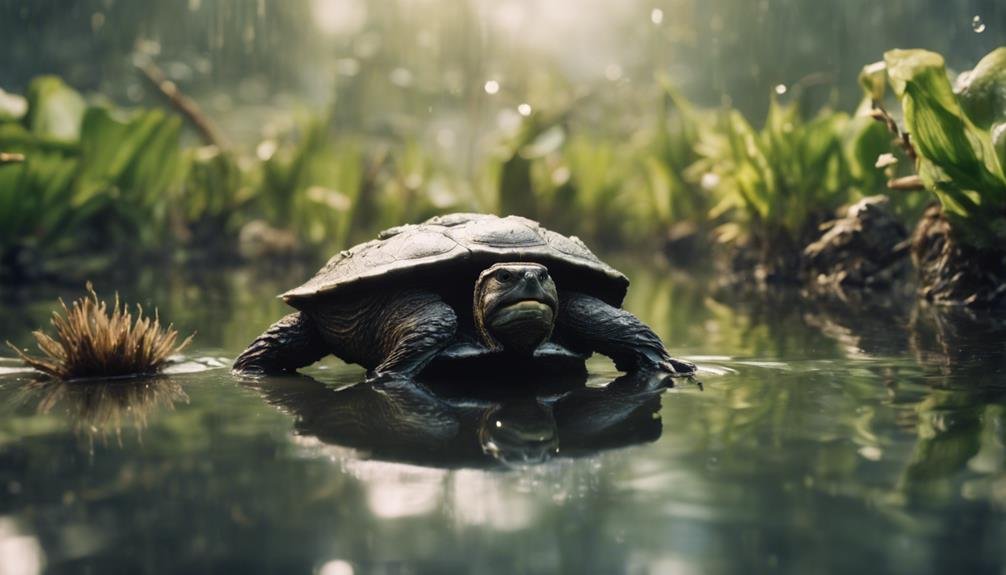

Snapping turtles interact dynamically with various species in their ecosystems, influencing both prey and plant populations. As you explore these interactions, it’s clear how integral these turtles are to maintaining ecological balance. They’re not just passive inhabitants but active participants in their habitats.
In the water, snapping turtles contribute to controlling fish and invertebrate populations by preying on or scavenging them. Their method of lying in wait and quickly ambushing prey shows their strategic role as predators. Despite their fearsome reputation, they’re not major threats to ducks and geese populations, but they do prey on vulnerable ducklings. This interaction, although seemingly harsh, is a natural part of ecosystem regulation, ensuring no single species dominates.
Here are a few intriguing ways snapping turtles interact with other species:
- Controlling Insect Populations: By feeding on various insects, they help manage these populations, preventing outbreaks.
- Scavenging Role: They clean up dead animals from their environments, which helps prevent the spread of disease.
- Impact on Amphibians and Small Mammals: Their diet includes these creatures, affecting their local populations and sometimes benefiting plant growth by controlling herbivore numbers.
Can a Snapping Turtle’s Diet Affect its Aggression and Likelihood to Bite?
Yes, a snapping turtle’s diet can affect its aggression and likelihood to bite. By ensuring that the snapping turtle has a well-balanced diet with the right nutrients and variety of food, you can help prevent aggressive behavior. Additionally, following preventing turtle bites tips can further reduce the risk of being bitten by a snapping turtle.
Conservation and Population Management
Understanding the dynamic role of snapping turtles in their ecosystems highlights the need for careful conservation and population management strategies. As you explore the life of these omnivorous reptiles, it’s clear that they’re not just surviving; they’re integral to the health of water ecosystems. They help maintain balance by consuming diseased and dead animals, thereby preventing the spread of pathogens and supporting cleaner, healthier environments.
Despite common misconceptions, research shows that snapping turtles don’t notably threaten game fish populations. In fact, other predators such as large fish and mammals pose a greater risk to these species. This revelation underscores the importance of targeted conservation efforts that don’t indiscriminately villainize snapping turtles but rather understand their specific impact and role.
Effective population management involves protecting their habitats and regulating human interactions, including limiting detrimental activities like unregulated hunting and habitat destruction. By prioritizing these actions, you’re contributing to a sustainable ecosystem where snapping turtles can continue to play their part. Remember, every species has a role, and understanding these roles allows for better conservation practices that benefit all wildlife, including those that call our water bodies home.
Conclusion
As you’ve learned, snapping turtles have a diverse diet that keeps aquatic ecosystems healthy. They’ll munch on both plant and animal matter, from algae to small mammals. When feeding a pet snapping turtle, it’s essential to mimic this variety to meet their nutritional needs.
Remember, their eating habits also impact other species and play a role in conservation efforts. By understanding and supporting their dietary needs, you’re helping maintain the balance of their natural habitats.

